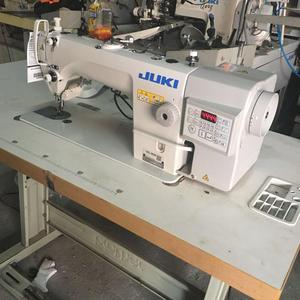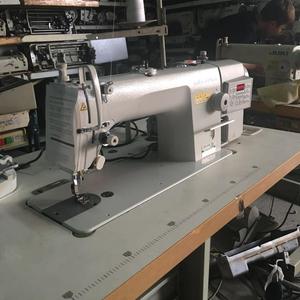
All categories
Featured selections
Trade Assurance
Buyer Central
Help Center
Get the app
Become a supplier

(5126 products available)





































Lock stitch sewing refers to the process of interlocking two threads in the fabric. The Juki lock stitch sewing machine is available in industrial and domestic models and is classified according to the sewing mechanism. These machines can be used to sew delicate fabrics such as silks and satins, as well as heavier materials like denim or leather.
Computerized lock-stitch machine: These lock-stitch machines are controlled by a computer, which allows for more precise stitching and automation of certain functions. They are ideal for high-volume production use where consistency and efficiency are essential. The computerized machine also comes with features like automatic thread trimming and backstitching, as well as programmable stitching patterns.
The following table provides detailed specifications and maintenance tips for Juki lock stitch sewing machines.
Speed: The highest speed of lock stitch sewing machines is usually expressed in the number of stitches per minute. This will vary depending on the model and application of the machine. Some machines may have a maximum stitch speed of a few hundred stitches per minute, while others can go up to a few thousand. Generally, industrial lock stitch sewing machines are faster than domestic ones.
Stitch Length: This refers to the distance between individual stitches. It is usually indicated in millimeters or fractions of an inch. The range of stitch lengths that a lock stitch sewing machine can produce varies depending on the model and application. For example, a machine for sewing garments may have a different stitch length range than a machine for sewing heavy fabrics.
Thread Type: Lock stitch sewing machines can use different types of threads. The specifications of the threads include composition, thickness, and strength. The appropriate thread type for a particular sewing project will depend on factors such as the material being sewn, the machine's needle and tension settings, and the desired seam appearance and strength.
Presser Foot Lift: The presser foot is an important component of a sewing machine. It is usually raised and lowered by the presser foot lifter, which determines the maximum height the presser foot can be lifted while sewing. This specification is usually indicated in millimeters or fractions of an inch. The presser foot must be lifted to allow the fabric to be fed and positioned under the foot before sewing. The presser foot lever can be used to lift the presser foot before and after sewing to remove the fabric from the machine.
Cleaning: It is important to keep the machine and work area clean. Regular dusting and debris removal can prevent the accumulation of lint and ensures that the moving parts of the machine are not affected.
Lubrication: Sewing machines have many moving parts that must be properly lubricated to operate smoothly and avoid excessive wear. Check the machine's manual to ensure proper lubrication points and use the correct type of sewing machine oil.
Thread and Needle Care: The quality of the finished product is affected by the type of thread and needle used in the sewing machine. Selecting the right thread size and needle type for the material being sewn is crucial. Regularly inspect the thread for signs of wear, breakage, or tangles. Needles should also be inspected and replaced frequently to prevent bending or damage. This is particularly relevant to lock-stitch sewing machines, as they cannot operate properly if the needle is bent or damaged.
Preventive Maintenance: In addition to regular cleaning and lubrication, lock stitch sewing machines require regular maintenance. This includes checking and adjusting the machine's tension settings, feed mechanisms, and other critical components to ensure proper operation and stitch quality. Preventive maintenance can help identify and address potential issues before they become more severe.
The versatility and durability of Juki lockstitch sewing machines make them invaluable in various industries. They are widely used for sewing various fabric types, weights, and thicknesses with lockstitch consistency. They are also used in different scenarios such as the following.
Juki lock stitch sewing machines are widely used in clothing factories. Whether it is a T-shirt, jeans, suit, or other clothing items, these machines can sew seams, hems, and other stitching details precisely and efficiently. The consistency and quality of the stitching meet the high standard requirements of mass production.
Juki lockstitch machines are also widely used in the home textile industry. Whether it is curtains, bedding, or decorative fabrics, these machines can sew different types of fabric with different thicknesses. The stitching is neat, firm, and beautiful, making it a reliable guarantee for production efficiency and product quality.
Juki lockstitch sewing machines can be used to sew automotive interiors, including car seats, door panels, and headrest covers. These materials are usually heavy and robust, such as leather, artificial leather, and canvas. Juki lockstitch sewing machines can handle these materials and meet the high standard requirements of the automotive industry for durability and quality.
Juki lockstitch sewing machines can also be used in the manufacture of shoes and leather goods. These machines can sew leather, artificial leather, and other shoe materials. They can complete the stitching of the upper, lining, and soles of the shoes with high precision and strength. The stitches are neat and beautiful, which improves the efficiency of shoe production and ensures the quality of the shoes.
Juki lockstitch sewing machines are also widely used in the medical textile industry. They can sew medical textiles, such as surgical gowns, masks, and bandages. Juki lockstitch sewing machines can achieve precise stitching, which ensures the safety and reliability of medical textiles.
Juki lockstitch sewing machines are also used in the production of uniforms such as police uniforms, military uniforms, and work uniforms. These machines can sew through a variety of fabric weights and thicknesses, ensuring the durability and quality of the uniforms.
When shopping for lockstitch machines online, one has to consider the needs of the end-users. They should begin by thinking about the type of material they will be sewing. If they will be working with heavyweight materials, they will need to get an industrial lockstitch machine that can handle the thickness of the fabric. However, if they will be working with lighter materials, they can choose a domestic lockstitch machine. Domestic machines are mostly used for home use and can handle materials like cotton and polyester. If one is unsure of which machine to get, they can consider getting a machine that can handle both materials.
Since users spend a lot of time sewing, they need a machine that is comfortable to use. They should look for machines with features like adjustable speed control, ergonomic design, and automatic functions. Automatic functions make sewing tasks more manageable. For example, automatic threading allows users to thread the machine quickly. Ergonomic design reduces fatigue, while adjustable speed control allows users to set the pace they are comfortable with.
When shopping for lockstitch machines, one has to consider the available space. Businesses with limited space may consider getting a portable machine. Most portable machines have a compact design, making them easy to move around. However, portable machines are not suitable for businesses that require heavy sewing throughout the day. Heavy-duty lockstitch machines are more substantial and take up a lot of space. Therefore, the user has to determine if they have enough space for the machine.
The type of control system and power source of the machine are also essential factors to consider. When sewing different types of materials, users may need to adjust the machine's speed. This is only possible if the lockstitch machine has a reliable control system. Users should be able to switch between automatic and manual sewing. For power sources, users have the option of choosing between battery-powered machines and electric machines. Battery-powered machines are more portable, while electric machines are more powerful.
Q1: What is the difference between lockstitch and chain stitch sewing machines?
A1: Lockstitch sewing machines, like the Juki lockstitch sewing machine, use two threads to create stitches. The top thread goes through the fabric, while the bottom thread forms a knot to secure the stitch. The chain-stitch sewing machine creates stitches by interlocking a single thread. This machine is commonly used to sew buttonholes and decorative stitching. Some machines can switch between chain-stitch and lockstitch, but they are not as common.
Q2: What kind of needle does a lockstitch sewing machine use?
A2: The Juki lockstitch machine uses needles with a flat side and a curved side at the back. This type of needle is known as an "M-style" needle. The M-style needle has a unique shape that helps it form perfect stitches without damaging the machine or breaking the thread.
Q3: Can lockstitch machines sew all types of fabrics?
A3: The Juki lockstitch machine can sew most common fabrics. However, it may not be suitable for some specialized fabrics. Delicate fabrics like silk or lace may get damaged or not sew correctly. In these cases, it is better to use a specialized machine that can handle the fabric's needs.